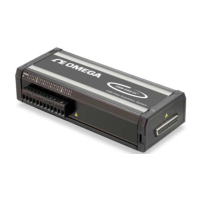4-12 Personal DaqView
989394 Personal Daq User’s Manual
When you select the measurement duration you also determine the maximum sample rate and resolution
for the applicable channel. For Personal Daq’s analog input applications, sample rates range from 1.6
samples/sec up to 80 samples/sec and corresponding resolution ranges from 22 to 15 bits.
The following table provides general advice regarding the selection of measurement duration.
Analog Input Signal
Variability
Measurement
Duration
Sample
Rate
Resolution
Steady, or gradual
change
long low high
Highly variable
(unsteady)
short high low
Frequency/Pulse Input Spreadsheet [Does not apply to Personal Daq/54]
The Frequency/Pulse Input spreadsheet allows you to configure the related channels. Each row shows a
single channel and its configuration. Additional information regarding frequency measurement is included
in the Help file.
Channel Configuration Window, Selected for Frequency/Pulse Input Spreadsheet
The following text provides more detail regarding the frequency/pulse channel configuration parameters.
Note that columns labeled Physical Channel, User Label, On/Off, Reading, Scale, and Offset are discussed
in the section, Common Spreadsheet Columns.
Type ⎯ A block of cells in this column can be selected for convenience of single type selection, where
type can be Frequency, Totalize, Pulses per Scan, or Duty Cycle (% High or % Low). The selected type
determines the default units.
Units ⎯ Frequency type units can be Hz or kHz. Totalize and Pulses per Scan type units are Pulses; and
Duty Cycle
(% High and % Low) type units are %. Default units are set in the Preferences section of the
Main Control Windows’s View pull-down menu.
Edge ⎯ Readings for Frequency, Totalize, and Pulses per Scan are based on successive rising [or falling]
edges of the input signal, and on the time lapse between these signal edges (see Debounce). Each
channel’s edge selection is independent of the others, i.e.; you can have some channels selected for rising
edge while others are selected for falling edge.
Note: Depending on the application, one edge type (rising or falling) may be electronically cleaner
than the other.
Note: As indicated in the following text and figure, some edges are insignificant and can be ignored.
Artisan Technology Group - Quality Instrumentation ... Guaranteed | (888) 88-SOURCE | www.artisantg.com

